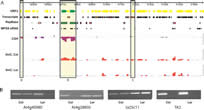Epigenetic variation in Arabidopsis thaliana
 Public Library of Science (PLoS) Biology. 5(7): e174. 2007
Public Library of Science (PLoS) Biology. 5(7): e174. 2007
Author Summary
In plants and animals, many DNA sequences are modified by the addition of methyl groups, but the principles governing methylation patterns are not well understood. In Arabidopsis, we show that repetitive sequences, derived from mobile (transposable) elements, are densely methylated throughout their length, while about one third of all protein-coding genes are internally methylated. Methylated transposons are silent, homologous to small interfering RNA, and coated with histone H3 dimethylated on lysine-9. In contrast, methylated coding-sequence genes are highly expressed, do not have corresponding small RNAs, and are coated with histone H3 dimethylated on lysine-4. Comparing two different ecotypes of Arabidopsis, we find that transposons are twice as likely as genes to have suffered insertion and deletion, although gene deletion is surprisingly prevalent. While the pattern of transposon methylation is conserved between ecotypes, protein-coding gene methylation is polymorphic so that only half of all gene methylation on any one chromosome is shared between natural accessions collected from around the world.
M. Vaughn, M. Tanurdzic, Z. Lippman, H. Jiang, R. Carrasquillo, V. Colot, R.W. Doerge and R.A. Martienssen.